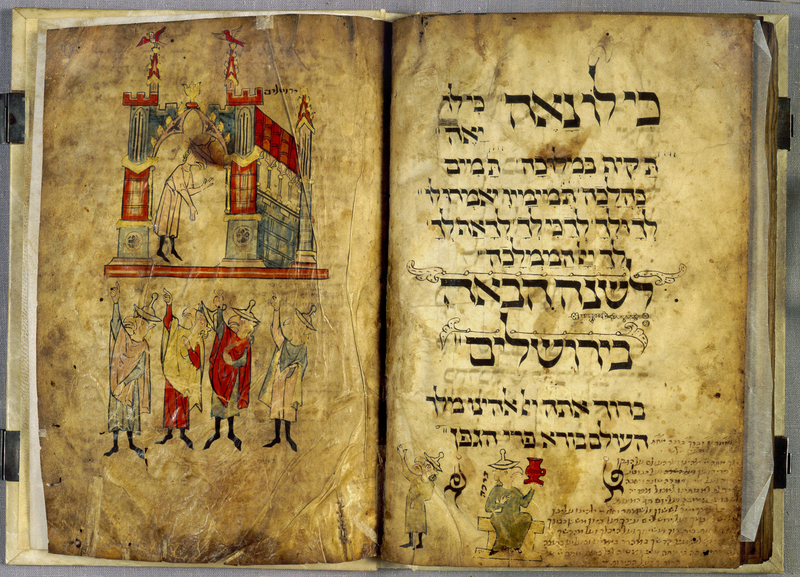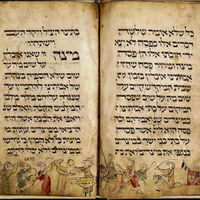The Birds Head Haggadah: Instructions, prayers, and notes
Introduction:
This haggadah was written by a scribe named Menachem in the middle or upper Rhine area, perhaps in Mainz, about 1300. It is one of the earliest examples in Ashkenaz of the book used by Jews during the Passover seder, a family ritual to commemorate the Exodus from Egypt.
The text on fols. 24v–25r comes toward the end of the “Maggid” section of the Passover haggadah, the “Telling” of the Exodus story. Here, the great rabbinic sage Rabban Gamliel (first century CE) focuses on what he considered the critical part of the seder, the service at home on Passover night. The passage begins on the previous page with the words, “Rabban Gamliel says.” The text runs continuously from one folio to the next with only a single paragraph break, highlighted by the enlarged word for matzo (מצה). Boldface used here and below indicates the words written in large black letters on the manuscript pages.
Translations: Some passages have been simplified and words added in brackets to aid comprehension.
[fol. 24v]
[fol. 26v]
This text serves both as the end of the “Maggid” section and an introduction to the first part of the “Hallel” section—“Praises” to God. The page opens with a large, framed word panel; the second line is somewhat smaller, making a transition to the standard-size text on the rest of the page.
This is the last stanza of a poem about God’s attributes that is sung at the end of the seder. Each stanza contains two descriptions of God and one adjective for angels, each beginning with the next letter of the alphabet. The last stanza uses the final letter of the Hebrew alphabet, ת, to begin all three parts.
A caption reading “Blessing” (ברכה) is written vertically next to the image of the man holding up the cup of wine. On the next page, fol. 47r, the ornate structure is identified as “Jerusalem” (ירושלים) by a caption at the upper right.
The text on fols. 24v–25r comes toward the end of the “Maggid” section of the Passover haggadah, the “Telling” of the Exodus story. Here, the great rabbinic sage Rabban Gamliel (first century CE) focuses on what he considered the critical part of the seder, the service at home on Passover night. The passage begins on the previous page with the words, “Rabban Gamliel says.” The text runs continuously from one folio to the next with only a single paragraph break, highlighted by the enlarged word for matzo (מצה). Boldface used here and below indicates the words written in large black letters on the manuscript pages.
Translations: Some passages have been simplified and words added in brackets to aid comprehension.
[fol. 24v]
Anyone who does not mention the following three things on Passover [at the seder] did not fulfill the obligation [of retelling the story of leaving Egypt].In a marginal note on fol. 25r, an early user of the haggadah wrote instructions about the proper actions to take upon reaching this point in the text:
They are: the Paschal lamb, matzo, and bitter herbs.
The Paschal lamb that our forefathers ate when the Temple was standing—it is because of what? Because God passed over the houses of our forefathers in Egypt, as it says [Exod. 12:27], “You shall say, ‘It is a Paschal sacrifice to God who passed over the houses of the Israelites in Egypt when he struck Egypt, and [25r] our houses He saved,’ and the nation bowed and prostrated themselves.”
This matzo that we eat—it is because of what? Because our ancestor’s dough did not have a chance to be leavened before the King, King of Kings, the holy one Blessed is He, revealed himself to them and redeemed them, as it says [Exod. 12:39], “They baked the dough that they took out of Egypt as cakes of matzo, as it had not leavened, because they were banished from Egypt and they were not able (25v) to delay, and they had not prepared provisions.” These bitter herbs that we eat—it is because of what? Because the Egyptians made the lives of our ancestors bitter in Egypt, as it says [Exod. 1:14], “They made their lives bitter with hard work, mortar and bricks, and all field work; any work that they made them do, they made them do with crushing labor.”
When one reaches this point, they should raise the matzo and say “This matzo.” My custom is to raise the big matzo [of three used at the seder] that is between the coverings [napkins]. Because for all three “[matzos] of commandments,” a commandment (mitzvah) was enacted for each one, and probably this middle one was not put here without reason. Therefore, one should raise them when one reaches here. So it seems to me.More words have been added to the picture at the bottom of fol. 25r. In black, above the figure holding the sack on her shoulders, it says “the dough” (הבצק—a reference to the verse above that begins on line 9). A second writer has added, in orange, the two preceding words: “They baked” (ויאפו את).
[fol. 26v]
This text serves both as the end of the “Maggid” section and an introduction to the first part of the “Hallel” section—“Praises” to God. The page opens with a large, framed word panel; the second line is somewhat smaller, making a transition to the standard-size text on the rest of the page.
Therefore we are obligated to thank, praise, extol, glorify, exalt, honor, bless, elevate, and acclaim the one who performed, for our forefathers and for us, all [27r] of these miracles: He took us out of slavery to freedom, from sorrow to happiness, from mourning to holiday, from darkness to a great light, and from servitude to redemption. We will say before him, Hallelujah!There are three additional notations on the page:
In the margin at the bottom left is written, “the miracles” (הנסים), which is the next word that appears on the following page. Such catchwords were placed at the end of groups of folios in a manuscript to signal the correct order of folios to the binder.
On the tablecloth is the word “Therefore” (לפיכך), likely meant to be a caption or “speech bubble” of what the people at the table are saying.At the top right is another set of instructions about the proper ritual action for this moment in the seder:
When one reaches here, he should raise the goblet in his hand and say “Therefore.” Rabbi Meir [a Talmudic sage and legal authority] would not remove it [the wine cup] from his hand until after saying [the blessing of] “the one who saved us” [which appears three paragraphs later].[46v–47r]
This is the last stanza of a poem about God’s attributes that is sung at the end of the seder. Each stanza contains two descriptions of God and one adjective for angels, each beginning with the next letter of the alphabet. The last stanza uses the final letter of the Hebrew alphabet, ת, to begin all three parts.
Because for Him, praise is befitting; because for Him, praise is proper. Strong in rulership. Perfect as proper. His perfect ones [angels] will say to him, “Yours and Yours, Yours because it is Yours, Yours and even Yours, Yours, God, is the kingdom.”The last two lines of the main text on the page are the blessing on the seder’s fourth cup of wine, which is then drunk. An early user of the haggadah then added, in the lower right margin, the lengthy blessing said after drinking wine (the original scribe did not include this, perhaps because he imagined that readers/seder participants would know this blessing by heart). The second scribe had to squeeze the words of the blessing into the available space. In modern haggadot, the blessing on and drinking of the fourth cup of wine comes before the declaration of “Next Year in Jerusalem,” which itself precedes the singing of this poem—the reverse order of what is written here.
Next year in Jerusalem
Blessed are You, our God, king of the world, creator of the fruits of the vine.
A caption reading “Blessing” (ברכה) is written vertically next to the image of the man holding up the cup of wine. On the next page, fol. 47r, the ornate structure is identified as “Jerusalem” (ירושלים) by a caption at the upper right.


